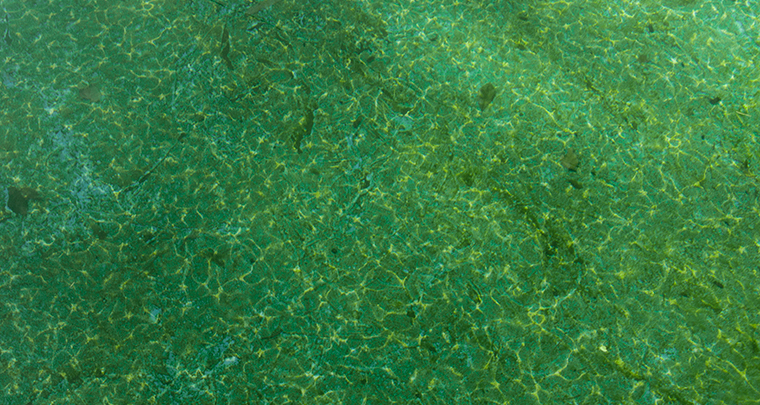How to Clean a Green Swimming Pool

It happens to the best of us. Despite our best efforts to maintain a clean swimming pool, every now and then the crystal clear water gets sullied with shades of green. What turns such a pristine pool into a swamp? How can we clean a green swimming pool and get the water back to normal? Green water is mostly attributed to algae: microorganisms that grow in water. While there are many different strains of algae that can exist in a swimming pool, green algae are the most common, hence the green color of the water. Algae can grow quickly in stagnant water, as well as water that doesn’t have enough sanitizer (such as chlorine) in it. Green algae are known to grow during extremely hot periods in the summer, and also during the spring while your pool is still closed since the water hasn’t been circulating. Thankfully, green algae are among the easiest to remove from a swimming pool. There are many methods to remove algae, including treatment algaecides and flocculants, however many cases of green algae can be removed easily and inexpensively with some prudent work and chlorine shock.
Test Your Pool Water
Don’t worry about checking your chlorine levels; if algae are present, that likely means there is little to no chlorine residual, which will be taken care of later. However, make sure your pH and Alkalinity levels are in balance. Balancing your pool chemicals will guarantee the following efforts to clean your pool work effectively. If either level is out of balance, treat your water with the appropriate balancing chemicals to achieve proper pH and alkalinity.
Prepare Your Pool
If there is a large amount of debris on the bottom of your pool, remove it with a leaf net on a telescopic pole. This type of leaf net is similar to a hand skimmer, but with a larger capacity net, designed to pick up larger items from your pool’s lower depths. We do not recommend using a hand skimmer for this task, as they are typically too small to effectively grab large debris. Do not attempt to vacuum the debris, as there will likely be too much and cause clogging in your pool system. If the algae are clinging to the pool walls or floor, take a pool brush and scrub the algae loose so it is free-floating in the water, making it easier to move with pool water circulation. It also creates a larger surface area for chlorine penetration when we add this to the pool.
Super Shock the Water
Adding an extreme boost of chlorine via shocking will effectively kill off the algae and clean a green swimming pool, getting the water back to normal. Normal shocking with granular chlorine requires approximately 1 lb. of granular shock per 10,000 gallons of pool water. Since algae have already formed, the amount of shock will need to be increased to account for the extra sanitizing work.
- If the algae is a light green color, you will need to double the amount of shock (2 lbs. per 10,000 gallons of water).
- If the algae is a darker green, triple the amount of shock (3 lbs. per 10,000 gallons of water).
- If the algae are dark to the point of looking nearly black (not to be confused with actual black algae), quadruple the amount of shock (4 lbs. per 10,000 gallons of pool water).
We recommend diluting the shock before adding it to your pool, especially if you have a vinyl liner, to prevent potential liner damage. Remember to dilute by pouring the shock into a bucket of water, not the other way around. Pouring water over pool chemicals can cause a dangerous chemical reaction. Wait to shock until nighttime to prevent the sun’s rays from damaging the shock before it can work.
Marathon Your Filter
Since algae grow while water is stagnant, using your pump and filter system will help prevent growth with water circulation and help catch & remove algae in tandem with the shocking routine. Run your filter system continuously for 24-36 hours, pausing only to backwash. You may need to backwash your sand filter or DE filter 3 or 4 times a day to keep up with algae being filtered and prevent pressure buildup or clogging. DE filters will require more filter media to be added after each backwashing. Cartridge filters will need to be rinsed off just as frequently during this process. Depending on how extreme the outbreak of algae is, this combination of shocking and filtering may need to be repeated in order to achieve completely clear water. However, even after one treatment with proper filtering, the pool water should lighten dramatically.
Preventative Measures
Once we clean a green swimming pool, how can we keep the algae from returning? Unfortunately, there is no way to entirely remove algae and other microorganisms from all water, and that’s okay. Microscopic algae are almost always present in some form; it only becomes a problem when it grows large enough to become visible. Thankfully, proper pool maintenance can help keep algae at a healthy (and invisible) level. We recommend taking the following steps:
- Chlorinate and shock your pool regularly. Keeping a proper level of sanitizer is the first line of defense against algae. Make sure your chemical levels are balanced properly.
- Use an algaecide as a preventative measure. While some algaecides are designed for treatment of algae outbreaks, they are often more expensive and contain certain elements which may prove problematic for your overall pool chemistry. A small dose of a basic algaecide added periodically will go a long way in keeping algae at bay.
- In addition to an algaecide, we recommend adding a phosphate remover to your pool. Adding a small preventative dose of this chemical removes phosphates, which are often considered “food” for algae, allowing them the chance to grow. Without phosphates in the pool, algae doesn’t stand a chance.
With a little work, the daunting appearance of a green pool can be restored to a beautiful crystal clear.






 Pools
Pools Spas
Spas Liners
Liners Equipment
Equipment Covers
Covers Accessories
Accessories Cleaning
Cleaning  Pool Fun
Pool Fun  Clearance
Clearance
